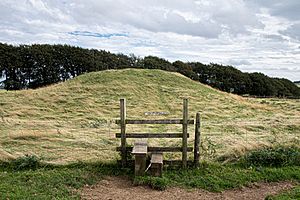Gib Hill facts for kids

Gib Hill burial mound
|
|
| Location | near Middleton-by-Youlgreave and Bakewell |
|---|---|
| Region | Derbyshire, England |
| Coordinates | 53°10′01″N 01°45′52″W / 53.16694°N 1.76444°W |
| Type | tumulus |
Gib Hill is a very old burial mound found in the Peak District area of Derbyshire, England. It's like a big, ancient grave. Experts believe it started as a long, oval-shaped mound from the Neolithic period (the New Stone Age). Later, a round mound from the Early Bronze Age was built on top of one end. You can find Gib Hill about 300 metres southwest of another famous ancient site called Arbor Low.
What is Gib Hill?
Gib Hill is a type of ancient monument called a tumulus or barrow. These are mounds of earth and stones built over graves. People from thousands of years ago used them to bury their dead. Gib Hill is special because it shows two different periods of history built into one mound.
Digging Up the Past
People have explored Gib Hill several times to learn its secrets.
- In 1812, the owner, Mr. Thornhill, did the first small dig.
- Then, in 1824, William Bateman and S. Mitchell explored it again.
- The most important dig happened in 1848, led by Thomas Bateman.
During the 1848 dig, archaeologists found a special stone box called a cist. This cist was from the Early Bronze Age. Inside, they found the remains of a cremation (where a body was burned) and a "food vessel." A food vessel was a type of pot likely used for offerings or to hold food for the journey to the afterlife.
The way the mound is built tells us a lot. It looks like an oval mound from the Neolithic period was built first. Then, a round mound from the Early Bronze Age was added on top of one side. If you look at Gib Hill from the north, you can clearly see these two different parts.
Where is Gib Hill Located?
Gib Hill is part of a group of ancient sites in the area. It's very close to Arbor Low, which is a large stone circle. It's thought that the Neolithic barrow at Gib Hill was one of the first important structures built in this ancient landscape. These sites together show us how people lived and honored their dead thousands of years ago.

